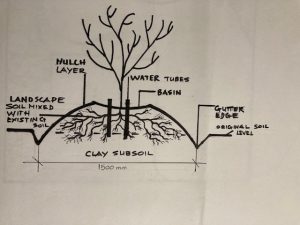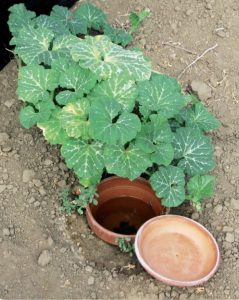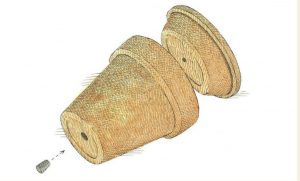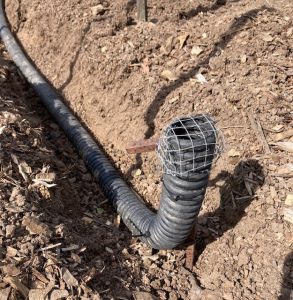Whether you agree with Climate Change or not, the fact is, as a country, we are getting hotter and hotter, while our rainfall is becoming more unpredictable at best.
Should we be only growing plants that can tolerate lower water usage? Is it even viable to keep growing our own vegetables if the worst happens and our regular rainfall dries up?

If water restrictions become the norm, can we sustain a healthy veggie garden and fruit trees on grey water alone?
Is it just too hard to contemplate?
The answer is NO……
Like the old saying goes…..we need to work smarter, not harder.
Planning is key and putting in the hard yards first may save both our water crisis and our beloved vegetable patch and orchard.
All of us have struggled with at least one garden problem through the last few years…be it mice plagues, birds raiding vegetable gardens, floods, fires, strong winds and extreme heat….and many of us are extremely time-poor and frazzled mentally since Covid 19 hit our shores.
So, what to do?
Here are some tips on how to make growing your own produce just that little bit easier and smarter this coming summer.
Most vegetable patches are set out to receive full sun, but with extreme heat and reduced water, this really puts your plants under a lot of stress, which if allowed to continue, brings on disease which means unhealthy and weak plants which are anything but healthy to eat.
Setup a temporary shade barrier to block out the harsh afternoon sun. Heat also warms up the ground around your plants, potentially poaching your plants alive. Use shade cloth or similar.
Mulch, mulch mulch…keeps the ground and root zones cooler.
Use dwarf fruit trees, they take up less space and need less water.
Plant the water-needy plants altogether and closer to the water source.
Double dig your garden beds and add plenty of compost and manure to retain more moisture, which will encourage worms and beneficial mycorrhizal fungi and nitrogen fixing bacteria, promoting a healthier plant.
Raise your beds to create more depth to hold moisture and cool the root zone.
When using grey water, start using eco-wise laundry liquid as they contain less salt, which builds up over time in the soil and eventually becomes toxic to the plant.
Avoid compaction of the soil as this inhibits water absorption.
Harvest every raindrop that you can using water pods or drums directly from your down pipes, if you live in town. Don’t let it go to waste through the storm water drain. Install rainwater tanks.
For trees in open paddocks, create ridges, swales and basins on the lower sloping sides to trap the water around your tree’s root zone.
11.Vertical mulching. This entails inserting upright sticks and twigs between your vegetable rows, this helps channel water deeper into the soil, while also creating shade and wind breaks to shelter your plants.
Choose vegetables and plants that require
less water like tomatoes, onions, shallots, garlic, chillies, olives and pomegranates.
Use under-mulch watering systems like
leaky hoses or Drip EZE irrigation.
There are also a few tricks that can help your garden survive longer periods between watering.
WATERING TUBES:
When planting new trees and shrubs, take the time to insert 2-3 watering tubes. These are just lengths of slotted ag line inserted vertically into the hole at planting time. Cover the protruding end with some wire mesh to keep snails etc from nesting in them and a small stake to let lizards climb out when they get curious. You can also insert watering tubes into existing tree root-balls using a crowbar. Simply pour your water directly into the tube which will take the water directly to the root zone not just a few centimeters down like regular watering.
OLLA POTS:


These traditional water reservoirs have been used for centuries in desert areas around the world. Originally, they were large rounded terracotta vessels, with narrow necks at the top. These can be expensive and very hard to procure locally. Fortunately, you can make your own.
We have just taken delivery of a big load of terracotta pots and saucers for just this purpose at the nursery.
Firstly, you need to block the drain hole in the pot. Secondly, bury the pots into your garden bed, just up to the rim. Fill with water and cover the top using a fitted terracotta saucer. Done!
Space these through your garden bed, a metre apart. The rate at which water is drawn from the pot, is determined by how much the plant needs to draw from the soil as it leaches through the pot walls. We have trialled these at the nursery. In well-constructed, compost rich soils, the pots went almost a week before needing to be filled again. These OLLA pots also reduce weed growth as there is little to no moisture on top of the soil for weeds to germinate. The use of thick mulch will also reduce weed growth while cooling the soil and trapping the water underground and reducing evaporation. Painting the saucers can also reduce evaporation through the clay.
You could also use wicks from these buried OLLA’S using natural hemp rope threaded through plastic tubing and then wrapping those lengths around the root zone of the plant.
UNDERGROUND AGLINE TRENCHES:

Using a post hole shovel, dig 30cm deep furrows the full length of your garden beds one metre apart. (But no longer than 3 metres long )Peg it down using wire or steel pegs. Raise each end of the Agline up and secure them to steel pegs, 100mm above the soil. Cover the ends with wire mesh to keep critters out.
Once installed, run water through them to make sure the level is correct, and that water flows evenly to each end. Once satisfied, backfill and cover with mulch.
These underground channels will transport moisture directly to the root zone of your plants like corn, peas, beans, tomatoes. Each season, cultivate the soil as usual, avoid disturbing the agline.
Grey water can be used on all of these applications. If and when it rains, these devices won’t create any problems like water-logging, whereas using water crystals and wetting agents may retain too much moisture should you get high rainfall due to flooding, like we have in the not-so-distant past.
When planting fruit and feature trees in your lawns or paddocks, use this simple strategy to ensure your trees grow healthy and fast. This trick is especially useful if you have heavy clay soil.
Mark out a circle measuring 1500mm wide, spray the grass with herbicide or hand weed. Remember the best soil is directly under the grass roots, so shake it vigorously to retain that good soil.
Using a sharp edged post hole shovel, dig 100mm around the edge to create a gutter, throwing that soil into the middle of the circle.
Using a mattock or crowbar, fracture the soil within the circle you’ve just cut.
Next add to this, 800 litres or one wheel barrow load of landscape soil or compost and manure and dig it through your existing soil for the best drainage and retention of water. As you plant your tree within this mounded bed, add your watering tubes, water the tree, then back fill the hole, (creating a basin around the trunk) water it again, then apply your mulch. The gutter around the edge of the circle will retain the mulch on the mound whilst also providing an edge to whipper snip for ease of maintenance. The basin around the trunk catches the water, directing it straight down into your well prepared soil. This process is a must for citrus trees as they dislike clay soil especially.
Happy gardening everyone, stay cool and hydrated, and never give up……………
Tanya Sawyer
Wingham Nursery and Florist
65534570
Winghamnurseryandflorist.com.au
